(With extensive extracts from John Gill’s piece in Classiclightweights.co.uk)
Early 1920s.  established the Carpenter business in 43 Penton Street, London N.1. near “The Angel”, Islington. This locality was becoming well known to lightweight cycle enthusiasts – several other famous “names” in frame building had their shops nearby.
established the Carpenter business in 43 Penton Street, London N.1. near “The Angel”, Islington. This locality was becoming well known to lightweight cycle enthusiasts – several other famous “names” in frame building had their shops nearby.
Car ownership was a luxury hobby exclusively for the rich – there were only 100,000 licensed drivers in London.
4/11/1922 Howard Carter discovered Tutankhamun’s tomb in Egypt.
1925 Carpenter introduced a range of imported sprint wheels, doubtless wood rimmed.
By the 1920s, all riders in the Tour de France were using Brooks saddles.
1927 This is the date of the earliest available Carpenter catalogue. Even at this early period the range includes two sporting tandems, a “Special Record Tricycle”, two path frames and both gents and ladies sports models. Clearly they have already become involved in sporting events with some success. They are also innovators of some note having introduced the hollow spindle and the revolutionary forward “quick release” rear ends which were soon adopted by other manufacturers.
Charles Lindbergh achieved fame with the first solo flight across the Atlantic in the fabric-covered ‘Spirit of St. Louis’.
The BBC was inaugurated. As almost no homes had electricity, It was quite a status symbol to have one of the lofty ariels needed to pick up signals with enough energy to power crystal set receivers.
Hoagy Carmichael’s ‘Stardust’ was the top selling sheet music of 1927.
1927 Tullio Campagnolo cursed the need to remove his wheel to change gear on the Croce d’Aune. “Bisogna cambià qualcossa de trio.” He patented his cam-operated quick release hub in 1930, formed his company in 1933 with a determination to innovate in the world of cycle components.
1928.The Representation of the People Act extended the right to vote to all women over the age of 21, the same terms as men.
1929 Aluminium alloy components were slowly gaining acceptance. Carpenter introduced a Duralium hub.
The Wall Street Crash on October 24th 1929 heralded the Great Depression.
In 1930 Car ownership remained rare. There were still only 260,000 licensed drivers in London.
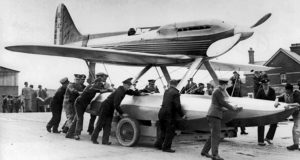 1931 Mitchell’s Supermarine S6.B racing seaplane won the international Schneider trophy outright at Calshott, achieving 407mph. Only 28 years had passed since Orville Wright’s first 7mph flight. How rapidly had technology advanced! The early wood-and-canvas airframes had gone. Reynolds H.M. (High Manganese) tubing was integral to the construction of this plane which became the prototype for the Spitfire. This material was widely adopted for lightweight cycle frames.
1931 Mitchell’s Supermarine S6.B racing seaplane won the international Schneider trophy outright at Calshott, achieving 407mph. Only 28 years had passed since Orville Wright’s first 7mph flight. How rapidly had technology advanced! The early wood-and-canvas airframes had gone. Reynolds H.M. (High Manganese) tubing was integral to the construction of this plane which became the prototype for the Spitfire. This material was widely adopted for lightweight cycle frames.
Rolls Royce developed the ‘RR’ family of high duty aluminium alloys for the Supermarine engine components. RR56 seat pins were introduced by Reynolds. (This alloy was marketed as ‘Hiduminium’ after WW2).
J.L. Baird made an experimental TV transmission of the Derby.
1931 Frank Carpenter married Beatrice Bartlett on the 21st Oct. in Chessington. Valerie was born the next year, Anthony in 1941.
1932 Unemployment exceeded 22% in Britain, even more in the North.
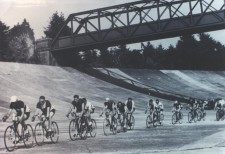 Massed start cycle racing, still prohibited on the public highway, became established at the motor-racing circuits of Brooklands, Crystal Palace and Donington Park.
Massed start cycle racing, still prohibited on the public highway, became established at the motor-racing circuits of Brooklands, Crystal Palace and Donington Park.
1934 Over 1 million private cars were now on the roads of Britain, a similar number of buses and lorries. Horse drawn vehicles had pretty much disappeared. For most, the primary means of transport was still the bicycle or public transport.
By this time the Carpenter marque had become established in the vanguard specialist builders of lightweight racing cycles. “This was the world of black alpacas and racing tights, of dawn starts and riding out on Saturday to overnight accommodation. We talked of Chater-Lea hubs, Selbach, Claud Butler and Carpenter cycles, the pride of every cyclist.” (Sid Hall recounting the early ’30s start of the Hemel Hempstead Cycling Club).
1934 Antonin Magne won the Tour de France using ‘Dura’ duraluminum rims. They weighed 750g compared with 1.2kg for steel rims. Banned by the rules, they were disguised in wood colours. The next year all the Tour bikes were fitted with ‘Dura’ rims. Descending the Galibier the Spaniard Francisco Cepeda was killed. The inquiry blamed for the accident on the gluing of the tubulars but aluminium alloy components remained under a cloud of suspicion.
1935 Reynolds introduced their now legendary ‘531’ tubing. This was destined to become the dominant tubing of lightweight cycles for over 50 years, first in Britain, then on the continent. 26 Tour de France winners from Charly Gaul (’58) to Big Mig Indurain (’91) used 531 frames.
Carpenter immediately adopted this tubing, offering “Reynolds H.M. or 531 tubing”.
1936 Brooks introduced the B17 Flyweight Flyer, incorporating a weight-saving aluminium alloy cantle-plate. Brooks were now selling almost 2 million saddles annually.
Economic recovery at last started, firstly in Southern England. The electrification of homes started, still only 12,000 homes had a supply by 1936. The lucky few could enjoy much improved lighting and wireless sets. Those living within 20 miles of Alexandra Palace could even indulge in the novelty of a TV service – if they could afford the price of a car for a set that delivered an indistinct flickering image.
Charlie Chaplin’s film ‘Modern Times’ was a comment on the desperate poverty of the ’30s depression.
1937 For the first time since 1919 the Tour de France organisers permitted the use of gears – but only Super Champion. Interest in the Continental racing scene was growing in Britain but the flat airfield circuit races sanctioned by the NCU were thin gruel indeed. Charles Holland and Bill Burl became the first British cyclists to ride the Tour. Burl lasted two stages, Holland retired after 14 with mechanical problems.
Walt Disney launched the world’s first full-length animated film – Snow White and the Seven Dwarfs
In this year Carpenter showed his ‘Ace Continental’ model with the Super Champion ‘Osgear’ gearing system, Reynolds 531 tubing, Brooks Flyweight saddle, RR56 seat pin and Italian Gloria alloy brakes – a leading edge specification for its day. See #3257
Over this period, Harry Grey worked at the Penton Rd address as a frame builder. He is reputed to have slept in the shop cellar for a period when digs were not available.
Wimbledon was televised for the first time, heralding a new era for all sports. In 1938 the Boat Race and FA Cup were also televised.
1938. Gino Bartali won his first Tour de France, using Super-Champion ‘Osgear’ with its striker-plate changer and separate chain tension/length adjuster mounted just behind the bottom bracket. Massed start road racing was introduced at the Empire Games in Sidney, bringing these into line with Continental championships. Both ‘Osgear’ and Sturmey Archer hub gears were in evidence. The search for competitive gearing systems was on.
Carpenter covered all bases, the 1938 catalogue shows the ‘Ace Continental’ (now dubbed ‘LA Continental’) with Super Champion derailleur, see #3257, the ‘SA Speed Ace’ with Sturmey-Archer AM (close ratio) or AR (ultra-close) hub gears. The ‘Short Markers Special’ is for the first time billed as the ‘BAR Road Racing’ with traditional fixed gears. The description for the first time claims “Many classic events have been won on this model, including England’s highest racing honour“. Strict amateur rules prohibited directly naming the rider in question but false claims in a published catalogue were equally unacceptable. This leaves the question: Which previous winner of the prestigious “Best All Rounder” competition was riding a Carpenter? Probably record breaker Cyril Heppleston, Yorkshire RC (1937)…. or possibly Olympic medallist and Tour de France pioneer Charles Holland, Midland C&AC (1936)?
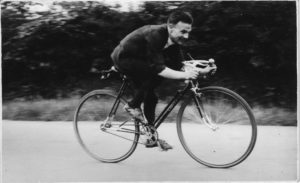 Jack Hedley of Hexham, time trialling on his Carpenter. Black alpaca jacket & leggings. Fixed wheel, the obligatory bell. Fixed wheel remained the standard for short and medium length time trials, the only road events available in Britain to racing minded clubmen.
Jack Hedley of Hexham, time trialling on his Carpenter. Black alpaca jacket & leggings. Fixed wheel, the obligatory bell. Fixed wheel remained the standard for short and medium length time trials, the only road events available in Britain to racing minded clubmen.
1939. In January Henry (by now 66) married again, to Beatrice A Dowdney (53). The census records him as a retired Silver Mounter, living at 58 Chessington Road, Elwell, Surrey; Frank as a Master Cycle Manufacturer & Engineer, of 152 Broom Road, close to Teddington Lock
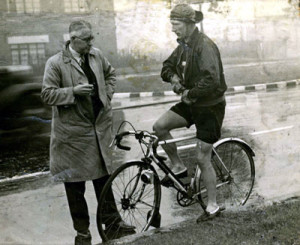 During 1939 vegetarian Tommy Godwin covered 75,065 miles (over 200 miles/day average) using a 30 lb. bike equipped with Sturmey Archer hub gears, mudguards, a cable-driven mileometer and dynamo powered lights. His record stood for over 75 years. He went on to complete 100,000 miles by May 1940 setting a record that stood until 2016. Sturmey Archer retained a following amongst racing cyclist for distance and hilly events.
During 1939 vegetarian Tommy Godwin covered 75,065 miles (over 200 miles/day average) using a 30 lb. bike equipped with Sturmey Archer hub gears, mudguards, a cable-driven mileometer and dynamo powered lights. His record stood for over 75 years. He went on to complete 100,000 miles by May 1940 setting a record that stood until 2016. Sturmey Archer retained a following amongst racing cyclist for distance and hilly events.
September 1st., 1939 Britain was again at war with Germany.
1940 British and Canadian troops were driven out of France from Dunkirk at the end of May, from July the Battle of Britain focussed on military targets. So for a year there was limited impact on civilian life in Britain itself, just intensive preparation for what was to come. Jack Manning, Charlotteville CC , won the last cycle race to be held on the Brooklands track, amassing enough points to beat Percy Stallard who was the first finisher. The Brooklands site was taken over to expand Vickers aircraft production, the banking partly destroyed to extend the landing strip into a runway. Motor and cycle racing there stopped forever. TV broadcasting was halted for the duration of the war.
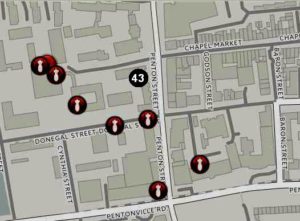
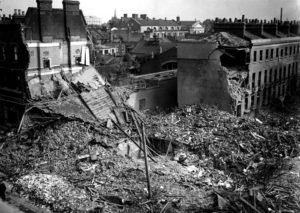 At first Luftwaffe bombing was directed at military installations – such as the Vickers factory in Weybridge on Sept 4 1940. Then the ‘Blitz’ bombing of British cities started on Sept 7 and continued ceaselessly for the next 57 nights. The Messerschmitt Bf109 escort fighters were at the limit of their range, the Battle of Britain had failed to destroy RAF Fighter Command. Hurricane and Spitfires cut into the bomber formations so Luftwaffe losses eventually proved unsustainable. Nonetheless many bombers got through. Over that winter 685 High Explosive bombs hit Islington alone including the junction of Donegal Street and Penton Street, close to the Carpenters’ workshop.
At first Luftwaffe bombing was directed at military installations – such as the Vickers factory in Weybridge on Sept 4 1940. Then the ‘Blitz’ bombing of British cities started on Sept 7 and continued ceaselessly for the next 57 nights. The Messerschmitt Bf109 escort fighters were at the limit of their range, the Battle of Britain had failed to destroy RAF Fighter Command. Hurricane and Spitfires cut into the bomber formations so Luftwaffe losses eventually proved unsustainable. Nonetheless many bombers got through. Over that winter 685 High Explosive bombs hit Islington alone including the junction of Donegal Street and Penton Street, close to the Carpenters’ workshop.
This blitz closed the Carpenters’ Penton Street business. With tubing and component suppliers devoting their production to the war effort, Carpenter cycle production ceased. Henry was 69 by now; he took no further active part in the business. It would be down to his son Frank to pick up the pieces once peace returned.
1942-44 BSA produced 60,000 folding bicycles for the Airborne Paratroopers, used extensively at Arnhem and the early stages of the D-Day landings.